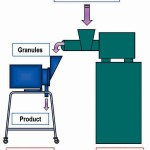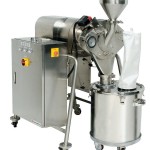Manufacturers of granules in the pharmaceutical and food industry are often confronted with the question of how to optimise different sized granules according to their particle size distribution. The continuously working Nebulasizer is ideal for standardising operations. It can be used for both wet and dry granules. Owing to its special operating principle, the Nebulasizer is particularly efficient for wet granules because they are more malleable than their dry counterparts. The amount of fines in wet products is reduced as a result.
Wilfried Pieper
The Nebulasizer provides a straightforward and efficient method for standardising particles. Even the smallest machine, which is capable of processing batches down to 1 kg, achieves an hourly capacity of between 50 and 80 kg. The machine has a compact design and only a few components. It is therefore easy to disassemble and clean, and can be quickly integrated into multi-purpose process lines. At the same time, it is well suited for continuous operation as a dedicated part of the plant. All components comply with the latest cGMP regulations.
One major advantage of this standardiser concept is the elimination of a sieve. Problems such as screen clogging or damage are now a thing of the past. Since there is no abrasion of particles on the sieve, the production of fine particles due to unwanted crushing is reduced to a minimum. A few examples from the pharmaceutical industry are presented in the following.
Standardisation of enzymes
Reflecting the increase in biotechnological products, enzymes are today a key element of pharmaceutical production. In the application described here, the raw material were cylindrical agglomerates supplied by an extruder. The typical agglomerate size was in the range from 8 to 20 mm. Approximately 10 % were fines smaller than 150 µm, however – mainly untreated particles. The agglomerates had an average moisture content of 70 %. Two parameters had to be optimised for the downstream drying and processing stages: on the one hand, the particle size with a maximum product recovery between 150 and 1100 µm and on the other hand, the particle roundness and strength.
The desired particle size range was achieved with the help of the Nebulasizer: 98 % of the total production was smaller than 1.1 mm. The fine particle amount was still around 10 %. The second requirement was likewise met: the particles were slightly rounded, compacted and stabilised.
The standardised product size had an extremely positive effect on the subsequent drying process. The product was dried faster and more homogeneously because the water in the pores has to cover a shorter distance to the point of evaporation. Energy consumption has been reduced as a result.
The stabilisation of the product shape due to the rolling movement between the stator and the rotor meant that no additional fines were generated during drying. The modified shape had a similarly favourable impact on the palletising and compacting processes.
Active substances are usually transformed into tablets by adding various excipients. A mixture frequently used for process analysis in the pharmaceutical industry consists of lactose, starch and cellulose. In the process described here, the excipients are first pre-mixed, then humidified and granulated or extruded. The particle size distribution is subsequently standardised prior to supplying the material to the compacter and dryer.
Trials with a mixture of the above components, to which 22 % water was added, yielded the following results: the spaghetti-shaped agglomerates emerging from the extruder were converted into particles between 100 and 1000 µm in size. This standardised size alone improves the properties of the product for further treatment. Flowability, and hence filling of the mould for tabletting, is just one example. In addition, the material is easier to dry and energy consumption is optimised.
Although the treatment of standardised, wet products is beneficial for the downstream steps, the Nebulasizer is also used for dry products owing, for instance, to the adhesion of the wet product, a lack of processing space or the existence of validated procedures. One important advantage of dry product standardisation with the Nebulasizer is that dust formation is reduced, or even eliminated, because there is no abrasion on the sieve.
One application for dry sizing in the pharmacy sector involves a mixture of urea, lactose, corn starch and cellulose. The moisture content of the product was 1 %, in other words the product is practically dry. The shape of the raw product resembles small, slightly curved sticks (similar to a banana), which are highly compacted and brittle. By treating the material with the Nebulasizer, it is possible to achieve uniform, millimetre sized grains. There is no unwanted dust.
Design variants
In view of the wide variety of applications and flow rates, the Nebulasizer is offered in two different designs. Firstly, it can be delivered as a laboratory model that is operated either as a standalone unit or as part of a multi-purpose lab impact and/or pin mill. This model is capable of handling throughputs from 1 kg batches to 80 kg/h. Secondly, the Nebulasizer can be built for dedicated production. The NS-20, NS-30, NS-40 and NS-60 machine types cater for this need with a throughput of up to several tons an hour. Standardisation tests can be carried out in Nara’s in-house laboratory. The service includes an analysis of the treated product as well as a test report.
cpp 437
Advantages at a glance
- Economic processing for wet and dry granulates
- GMP-design for fine chemicals and food
- No additional sieving necessary
- No unwanted crushing
- No clogging due to screenless design
- Easy disassembling and cleaning
- Flow rate from 1 kg to 3 t/h
- Compact design
The Nebulasizer
Share:








